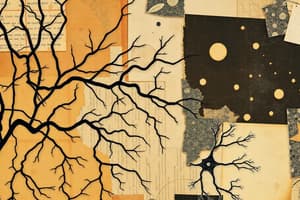Podcast
Questions and Answers
Which of the following is NOT a learning objective of the lecture?
Which of the following is NOT a learning objective of the lecture?
- Summarize how transport can occur across the cell membrane
- Calculate total body water, intracellular and extracellular fluid, and blood volumes (correct)
- Explain the characteristics of cell membranes, including the phospholipid and protein components
- Describe the major ions in the ICF and ECF
What are the two major fluid compartments in the body?
What are the two major fluid compartments in the body?
- Cerebrospinal and synovial fluid
- Intravascular and interstitial fluid
- Blood and lymph fluid
- Intracellular and extracellular fluid (correct)
What are the characteristics of cell membranes?
What are the characteristics of cell membranes?
- Nucleic acid and protein components
- Carbohydrate and nucleic acid components
- Phospholipid and protein components (correct)
- Carbohydrate and lipid components
Which of the following is NOT a feature of carrier-mediated transport?
Which of the following is NOT a feature of carrier-mediated transport?
What are the three examples of primary active transport mentioned in the text?
What are the three examples of primary active transport mentioned in the text?
Flashcards are hidden until you start studying
Study Notes
Fluid Compartments
- Two major fluid compartments exist within the body:
- Intracellular Fluid (ICF): fluid within cells
- Extracellular Fluid (ECF): fluid outside cells
- Interstitial Fluid: fluid that surrounds cells, occupying the space between cells and blood vessels.
- Plasma: fluid within blood vessels.
Cell Membranes
- Cell membranes are selectively permeable barriers:
- they control the movement of substances between the intracellular and extracellular environments.
- composed of a phospholipid bilayer with embedded proteins:
- Phospholipids: form a barrier between the ICF and ECF, with hydrophilic heads facing the aqueous environment and hydrophobic tails facing inwards.
- Proteins: play crucial roles in transport, cell signaling, and other functions.
Carrier-Mediated Transport
- Carrier-mediated transport: movement facilitated by specialized membrane proteins called carriers.
- Features:
- Specificity: carriers bind to specific molecules.
- Saturation: a limited number of carriers exist, leading to a maximum transport rate when they are fully occupied.
- Competition: different molecules may compete for the same carrier.
- NOT a feature:
- Simple Diffusion: movement of molecules across a membrane without the assistance of a carrier.
- Features:
Primary Active Transport
- Primary active transport: energy derived directly from the breakdown of ATP:
- Examples:
- Sodium-potassium (Na+/K+) pump: moves Na+ out of the cell and K+ into the cell, creating a concentration gradient used for other transport processes.
- Calcium pump: pumps Ca2+ out of the cell, maintaining low intracellular Ca2+ levels.
- Hydrogen pump: pumps H+ ions across membranes, generating a proton gradient used for energy production.
- Examples:
Studying That Suits You
Use AI to generate personalized quizzes and flashcards to suit your learning preferences.



